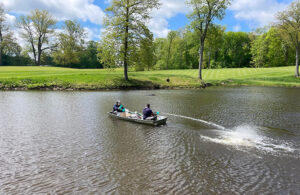The Root of the Matter
You can’t stop root loss from occurring, but you can control it so greens can make it through the summer unscathed
What do you get when you combine small greens, heavy golfer traffic, searing heat, high humidity and no air movement?
The ultimate turf stress.
 Several things contribute to the demise of a green’s root mass, including heavy golfer traffic. |
That kind of intense stress can damage a green’s root mass severely. And a green without root mass is kind of like an automobile without an engine: Both won’t work without the other.
It’s no scientific secret that root mass changes with the seasons in many regions. A green’s greatest root mass is found in April and May. The smallest root mass is measured from August through October. But the loss of root mass in greens from the stress of summer on golf courses in the Midwest, Northeast, South and throughout the transition zone can be startling.
“Root mass can decline dramatically during the summer months,” says Mark Mahady, president of Mark M. Mahady & Associates, a turfgrass consulting firm in Carmel Valley, Calif. Mahady states that research conducted by Fred Yelverton, a turfgrass professor at North
Carolina State University, shows that creeping bentgrass root mass may decline up to 76 percent from May through September.”
It doesn’t matter if a course’s greens are large or small, bentgrass or Poa annua or have a cool breeze blowing through them or not. If the course is located in an area where temperatures soar into the 80s and 90s and the humidity is stifling – which are normal summer conditions in many regions – the course’s greens will experience root loss.
Stress comes naturally to turf from the increase in temperature, Mahady says. For instance, research conducted by Bingru Huang, while an assistant professor at Kansas State University (presently at Rutgers University), showed that photosynthesis declines in creeping bentgrass as temperatures increase above 68 degrees Fahrenheit.
 A roller can be used to increase green speed. |
The temperature is also hotter – from 5 degrees F to 9 degrees F – on the turf’s canopy.
What’s a superintendent to do? Simple. He or she needs to monitor the root mass on the course’s greens during the summer months. Superintendents can’t stop root loss in greens from occurring, but they can control it so their greens make it through the summer unscathed.
To preserve root mass, Mahady says bentgrass and Poa annua greens need to be maintained gently from August through October. Most importantly, that means raising the mowing heights. Mowing greens too close in the summer for the sake of keeping them fast will cause root mass to diminish even more,
Mahady stresses. Raising the height of cut not only helps preserve root mass, it also helps suppress disease because the plant is more vigorous.
“It’s the same with you and me,” Mahady says. “If we take better care of ourselves – we don’t smoke, we eat properly and we exercise – we’re going to get through those times when we have bad colds. It’s the same concept with turf.”
But the height-of-cut issue is a tricky one for some superintendents, especially ones at high-end clubs where golfers want fast greens consistently. Some superintendents say raising the height of cut in mid-summer is easier said than done.
Jon Jennings, certified superintendent of the Chicago Golf Club in Wheaton, Ill., agrees with Mahady’s philosophy, but says he would hear complaints from members if he adhered to it.
“It would be nice to mow at a higher height and reduce some of the stress,” Jennings says. “But that’s not realistic here.”
John Burns, certified superintendent of The Gauntlet at Curtis Park in Fredricksburg, Va., doesn’t prefer to raise the height of cut on his course’s greens, but he will if it means protecting them. “The golfers don’t really like it much, but sometimes you have to do what you have to do,” Burns says.
On a good summer day, The Gauntlet might do 200 rounds. Burns realizes that stress from the traffic combined with the heat humidity could equal trouble for the course’s greens.
“If we have a few greens that are stressed, we’ll walk mow them at a higher cutting height from June through August,” he says.
While some newer bentgrasses can withstand the stress of close mowing heights, the Gauntlet’s Pennlinks greens can’t, Burns says. Still, even though newer varieties feature more heat tolerance, they still need to be maintained gently during the summer heat, Mahady stresses.
“I can’t emphasize enough how important it is to raise your mowing heights once you get into August,” Mahady says, noting that superintendents can still roll greens to keep them fast.
Mahady realizes that some superintendents will take flak from members for having slower greens. He says they need to try to educate their courses’ owners, green committees and members that what they’re doing to preserve root mass in the summer is in the best interest of the turf. There are cultural practices that should be performed and those that shouldn’t be performed to maintain healthy roots.
A big “should not” is double cutting greens unless there’s a tournament being played, Mahady says. Superintendents should also refrain from heavy sand topdressing and large-tine aeration.
“If you need to vent the greens, use quarter-inch hollow tines during August and September,” Mahady says. “Open them up, pick up the plugs and roll them out.
Burns agrees with Mahady. He’ll double cut greens, but only if the course is staging a tournament such as the member-guest. He will topdress greens every few weeks, but very lightly.
“You have to be careful about any cultural practices you’re doing,” Burns says. “I know people scream about cutting heights, but grass putts a lot better than dirt.”
Mahady is also a proponent of kelp-based biostimulants to increase root mass. But it’s important that biostimulant programs are implemented before the start of summer so root mass can accumulate. Mahady says greens should be treated with biostimulants every two weeks from April through October. Biostimulants won’t stop roots from diminishing, but the extra growth they spur can slow the process.
A superintendent must begin in the spring to maintain healthy roots in the summer, Burns says. To achieve that, Burns and his crew perform two aerations – one coring and one deep tine – in late March. “We do one quarter-inch coring and blow the cores off, and then we do a half-inch deep tine about 10 inches to 12 inches down,” he says.
During the summer, Burns will also spike his greens to open them up and keep air and water flowing sufficiently to the roots. Burns also uses wetting agents to keep moisture in the soil.
He says the key is for greens to go into the summer with as much root mass as possible. Then any loss isn’t as crucial.
“If you lose 75 percent of 2 inches, you’ve lost a lot,” he says. “If you lose 75 percent of 4 inches, you’re doing a little better.”
While superintendents should strive to build root mass in the greens, they should all strive to keep them as dry as possible in the spring to prepare them for summer’s onslaught. “You want to pre-stress them by drying them out,” Burns says.
Some superintendents can get away with not coddling their course’s greens. In the heat of the summer, Jennings continues to mow the Chicago Golf Club’s greens at .115 inch so they roll at 10 feet or higher consistently. He and his crew also double cut the greens two or three times weekly and roll them three or four times a week. Jennings also doesn’t back off from topdressing and verticutting or brushing every other week.
How is Jennings able to do that? Carefully. But Jennings admits the Chicago Golf Club is different than other courses in some important aspects that relate to cultural practices.
For example, the greens are big, averaging about 7,400 square feet. The course also only averages about 7,000 round a year. Large greens and lack of traffic minimize stress. It also helps that the greens are in open areas where air movement is at a premium. Oh yeah, they drain well, too.
“We have such a good growing medium on the greens that we don’t see a significant decline in root growth, although there is some during the hotter parts of the summer,” Jennings says.
The Chicago Golf Club’s greens are also about 70 percent Poa annua, which doesn’t have as deep a root system as bentgrass. Hence, Jennings, who cuts cups at the course, is constantly monitoring root growth during the summer.
“We’re trying to provide the best playing conditions possible,” Jennings says. “But with Poa being a more sensitive plant than bentgrass, you have to be careful. There’s a fine line between dry and dead.”
One thing Jennings does in the summer is implement a thorough syringing program to keep greens cool.
Syringing is vital to cool the turf and sustain root mass. Mahady says turf canopy temperatures can be reduced several degrees by proper syringing and increasing height of cut during the hot months.
“You’re really not trying to get water down into the root zone,” Burns says. “You just want to cool off the turf’s canopy.”
Bentgrass greens don’t require as much syringing as Poa greens because they’re more drought-hardy and have more root mass. Hence, Jennings says he and his crew must syringe longer into the day in the summer, sometimes until 7 p.m.
Mahady stresses that water quality is a huge issue when it comes to syringing. “It’s dangerous to syringe with poor quality water,” he says. “You don’t want to put on fine layers of salt.”












